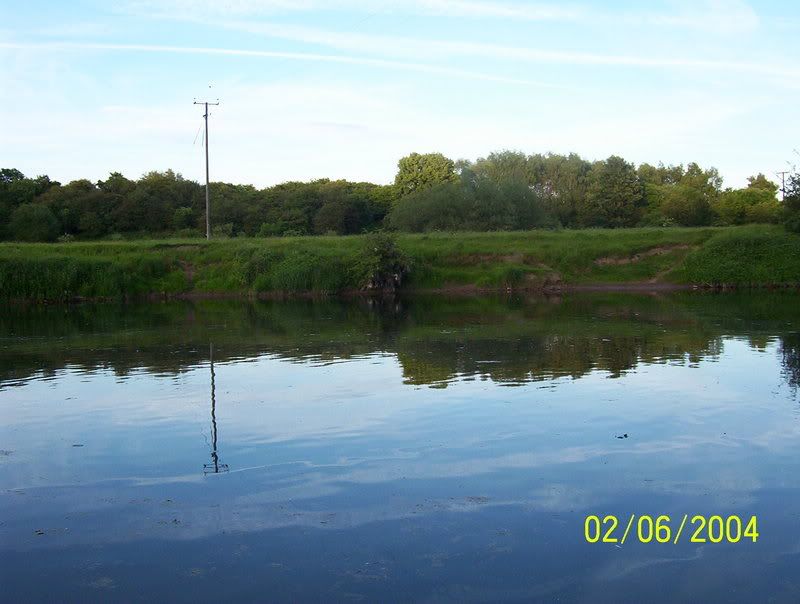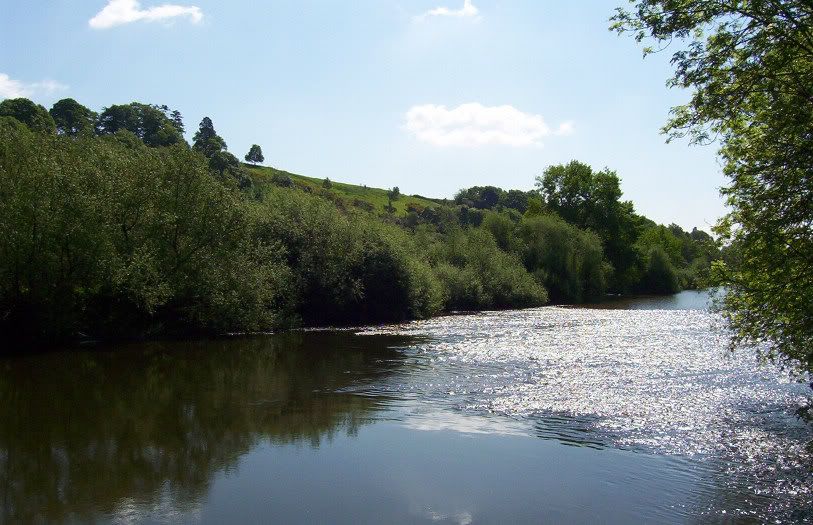Post by severnfisher on Sept 20, 2006 12:19:17 GMT
The fords are the natural crossing points at low water. All the old settlements in the Severn valley are based on fords. On a rough estimate there is one every 3/4 of a mile on the sections of river I know best. But sections vary greatly.
There are no weirs or artificial obstructions in the way of the salmon in the sixty odd river miles of the Middle Severn between Lincomb weir at Stourport and Shrewsbury weir. So the only thing holding them up is the fords.
As you would expect it is below the fords that the salmon pools tend to be found.
On dead low water perhaps one pool in 5 below a ford might have salmon in it, fly fishing is then mainly restricted to those pools that have suitable necks or tails - which is not that many.
If you are really lucky you might just find a pool that by utilising all tactics available can be fly fished throughout. Unfortunately quite a few pools look like this. (It is 4 feet deep in the margins with a twenty five foot high bank behind you to add to the tactical challenge)

Hence the predeliction of severn salmon anglers for worm and shrimp. (Notice the electric pylons by the way)
However, things change very quickly with only a bit of water. All the fords come into play as the salmon pause awhile either before or after traveling through. This pattern holds for most salmon rivers, but the specific relevance to the Severn is that fly fishing becomes more varied and mobile and less a case of going through the card over a very limited piece of water. If you choose an area with a few fords and fast runs close together, then add just a wee bit of extra water, you've got a nice big beat of viable fly water. During normal low water times you might only have 200 yards of viable fly water in ten miles available to the traditional salmon fly tactics.
There is nothing new here I know, but the reason I go on about the fords is that the current Severn salmon scene is mainly centred on a few well known dubs and weir pools. In the old days when there was a considerable amount of fly fishing done on the middle river the focus of activity for the fly rod was the fords (see for instance Silver Stoat's comments on the 'Flies for the Severn' thread). From the sixties onwards fly fishing declined as the runs got less predictable and modern transport systems made other distant salmon rivers more accessible. The barbel explosion then turned the Severn into a veritable mad house after June 16th. You needed to be on the river by 4am on a weekday to 'book' a peg on the faster water. At weekends virtually all of the river was booked for contests. Today with the decline of rivers and the rise of commercial stillwater coarse match fishing things have changed. Outside the holiday periods and a few barbel hotspots the Severn is now a river relatively empty of anglers for the first time since the the rise of match based coarse fishing clubs at the end of the 19th century.
Running heights and patterns
The middle of June 2006 saw a very spectacular run of fish through the middle river. With experienced hands commenting that it was like the Severn salmon runs of old with numbers of fish that they hadn't seen for many years. This run occurred at water levels of just 0.04m above normal level for Shrewsbury to Bridgnorth and 0.15m below normal level for Bridgnorth to Worcester. The Water temp was 20.5c at Bewdley. It was as if the may/june run was pushing on to the headwaters before the heatwave arrived.
For reference: the river is close to dead summer low and showing its bones once it is down to 0.25 below for Bridgnorth to Worcester and 0.05 Shrewsbury to Bridgnorth.
Some Grilse and even a percentage of the MSW fish will take the fords even in very low water so long as the river doesn't get too hot. Last night there were a few fish pushing through above me over a ford in only 18 inches of water with water levels down to 0.27 below. Maybe they sense the rain coming?
Hope so.
There are no weirs or artificial obstructions in the way of the salmon in the sixty odd river miles of the Middle Severn between Lincomb weir at Stourport and Shrewsbury weir. So the only thing holding them up is the fords.
As you would expect it is below the fords that the salmon pools tend to be found.
On dead low water perhaps one pool in 5 below a ford might have salmon in it, fly fishing is then mainly restricted to those pools that have suitable necks or tails - which is not that many.
If you are really lucky you might just find a pool that by utilising all tactics available can be fly fished throughout. Unfortunately quite a few pools look like this. (It is 4 feet deep in the margins with a twenty five foot high bank behind you to add to the tactical challenge)

Hence the predeliction of severn salmon anglers for worm and shrimp. (Notice the electric pylons by the way)
However, things change very quickly with only a bit of water. All the fords come into play as the salmon pause awhile either before or after traveling through. This pattern holds for most salmon rivers, but the specific relevance to the Severn is that fly fishing becomes more varied and mobile and less a case of going through the card over a very limited piece of water. If you choose an area with a few fords and fast runs close together, then add just a wee bit of extra water, you've got a nice big beat of viable fly water. During normal low water times you might only have 200 yards of viable fly water in ten miles available to the traditional salmon fly tactics.
There is nothing new here I know, but the reason I go on about the fords is that the current Severn salmon scene is mainly centred on a few well known dubs and weir pools. In the old days when there was a considerable amount of fly fishing done on the middle river the focus of activity for the fly rod was the fords (see for instance Silver Stoat's comments on the 'Flies for the Severn' thread). From the sixties onwards fly fishing declined as the runs got less predictable and modern transport systems made other distant salmon rivers more accessible. The barbel explosion then turned the Severn into a veritable mad house after June 16th. You needed to be on the river by 4am on a weekday to 'book' a peg on the faster water. At weekends virtually all of the river was booked for contests. Today with the decline of rivers and the rise of commercial stillwater coarse match fishing things have changed. Outside the holiday periods and a few barbel hotspots the Severn is now a river relatively empty of anglers for the first time since the the rise of match based coarse fishing clubs at the end of the 19th century.
Running heights and patterns
The middle of June 2006 saw a very spectacular run of fish through the middle river. With experienced hands commenting that it was like the Severn salmon runs of old with numbers of fish that they hadn't seen for many years. This run occurred at water levels of just 0.04m above normal level for Shrewsbury to Bridgnorth and 0.15m below normal level for Bridgnorth to Worcester. The Water temp was 20.5c at Bewdley. It was as if the may/june run was pushing on to the headwaters before the heatwave arrived.
For reference: the river is close to dead summer low and showing its bones once it is down to 0.25 below for Bridgnorth to Worcester and 0.05 Shrewsbury to Bridgnorth.
Some Grilse and even a percentage of the MSW fish will take the fords even in very low water so long as the river doesn't get too hot. Last night there were a few fish pushing through above me over a ford in only 18 inches of water with water levels down to 0.27 below. Maybe they sense the rain coming?
Hope so.

 Just a well travelled manc who ended up out here. Maxine and the kids are though. My lad says things like 'carsull' for castle and 'daard' for dad. Propur wusturshur.
Just a well travelled manc who ended up out here. Maxine and the kids are though. My lad says things like 'carsull' for castle and 'daard' for dad. Propur wusturshur.